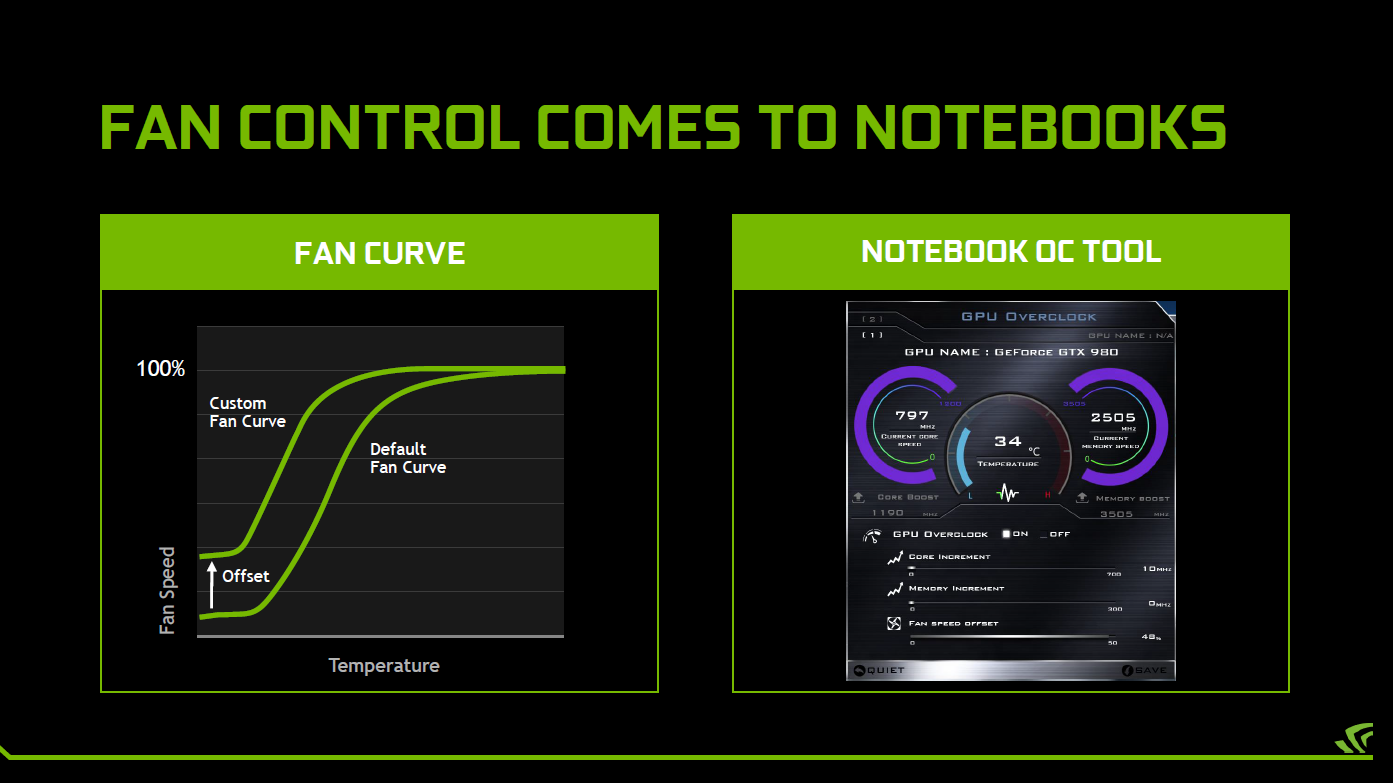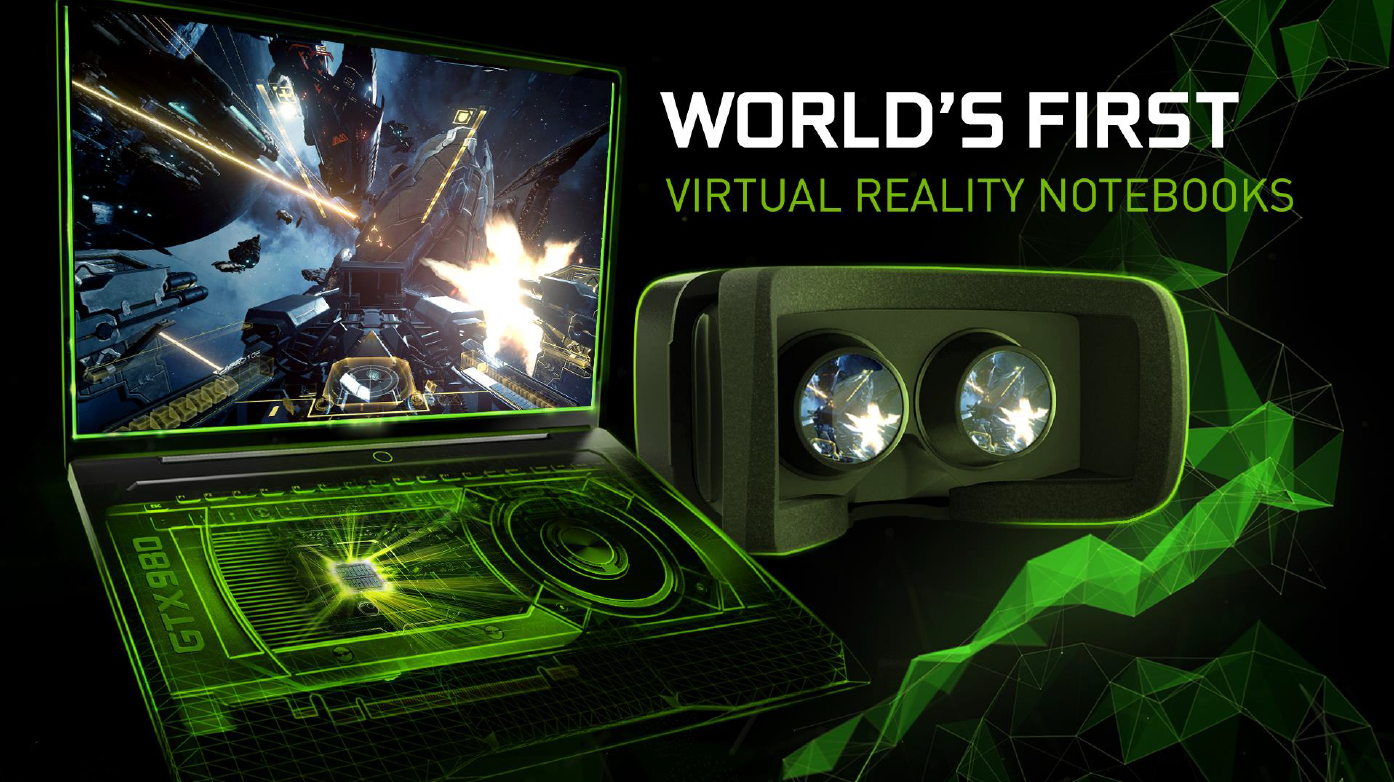Nvidia Stuffs Desktop Graphics, Water Cooling Into Laptops
Nvidia, like most companies, has boasted in the past about "world first" achievements it may or may not have innovated, but this time around it would be hard to argue with that point. Nvidia, along with partner OEMs, has put desktop-class graphics performance (and all of its benefits) into laptops. Not just any graphics card either; a full-sized GM204 Maxwell-based graphics card, better known as the Nvidia GeForce GTX 980.
Love At First Sight
When the flagship GTX 980 first launched, we were impressed by the fully-enabled GM204's performance and the second-generation Maxwell architecture's capability to do more with less. Energy consumption and temperatures were lower, performance was higher, and its pricing was disruptive to the graphics card market, redefining the limits of graphics horsepower in a single card and presenting consumers with hardware powerful enough to drive up to six million pixels and future innovations such as VR devices and 4K displays.
The reference design for the GTX 980's 2048 CUDA cores runs at a 1126 MHz base clock rate with a rated 1216 MHz GPU Boost frequency with 4 GB of GDDR5 clocked at 1725 MHz, or 7 GT/s, and the mobile version of this graphics card does not compromise on any of those specs or capabilities. It's a graphics processor in a laptop hitting a 7 Gbps memory clock. We were even shown a few side-by-side comparative benchmarks that pitted a sample laptop against a desktop with a GTX 980, and the results were nearly identical (the difference in score from a 3DMark bench was only 15 points).
The Thermal Challenge
Putting a full-sized GTX 980 into a laptop doesn't come without a few challenges. Giving it the same overclocking headroom as its desktop counterpart makes it even more difficult. In the past, power consumption and thermal output was much higher, and the Maxwell architecture was a prime candidate for premium performance at low thermal and power ceilings. The advent of unlocked Skylake processors in the mobile space also allowed the performance ceiling for laptops to significantly rise, and the PCB of the GTX 980 was redesigned to fit into laptops. But those alone aren't enough to implement such a feat. There needed to be an effective method to cool these powerful components.
OEMs Lend A Hand
Partner OEMs had to redesign their thermal solutions to accommodate the inclusion of unlocked processors and graphics cards in a laptop, and several are already on board. So far, Asus, Clevo, Gigabyte and MSI answered the call, and Nvidia announced several models from those companies sporting the GTX 980 and featuring G-Sync displays and unlocked Skylake processors, with some even offering water cooling (another first) and SLI configurations. We'll take a closer look at these powerful gaming laptops as full specs become available from the OEMs, but they all had to overcome the same thermal challenges, and were successful in doing so, from the demos we saw.
Even More "Firsts"
Redesigning the thermal solution included adding native fan control, which Nvidia claimed is another first for laptops. Although some OEMs have added the ability to toggle fan speeds in the past, the keyword in that statement was "native," and the new feature is hardwired right into the PCB. Allowing enthusiasts to manipulate fan speeds lets the user decide the balance of noise and performance, and ultimately the overclocking headroom. OEMs also had to accommodate for the increased power requirements, so these new laptops come with 4- to 8-phase power supplies. Yet another first, according to Nvidia.
Along with the other aforementioned "firsts," these new laptops will be capable of supporting VR devices such as the Oculus Rift. The powerful combination of an unlocked Skylake processor and Nvidia GeForce GTX 980 offers more than minimal specifications for running the new technology.
Get Tom's Hardware's best news and in-depth reviews, straight to your inbox.
Coming Soon. Very Soon.
The best part about this announcement is that this isn't some far-off fairy tale or concept development. These laptops will be available very soon. Asus, MSI, Gigabyte and Clevo will be among the first to market with the new innovation, with more OEMs likely to follow suit. This development has basically created a whole new market segment: the mobile enthusiast, with laptops designed for record performance with premium components that are built for overclocking.
We'll have to see how the battery life on these systems hold up, but we can't imagine you'll be gaming very long on it with horsepower like this.
Follow Derek Forrest @TheDerekForrest. Follow us @tomshardware, on Facebook and on Google+.
Derek Forrest was a contributing freelance writer for Tom's Hardware. He covered hardware news and reviews, focusing on gaming desktops and laptops.
-
Oldbutstillatit Desktop GPU's have been stuffed into laptops before. Like before, the cost will kill them.Reply -
realnoize Ok. So either we get 15-min. game time on battery or these are packed with mega-huge (and heavy) batteries. Battery life in gaming laptops is already low at generally about an hour or less of game time with mobile GPUs, I can't imagine what it will be we a full desktop GPU in there.Reply -
xenol I'm finding it ridiculous just how much they're stuffing in these notebooks. And at the end of the day I still won't consider anything high end not because of price, but because of how freakin' huge they get.Reply -
realnoize Reply16666265 said:I'm finding it ridiculous just how much they're stuffing in these notebooks. And at the end of the day I still won't consider anything high end not because of price, but because of how freakin' huge they get.
There are options out there which are, IMO, not really bigger than your average run-of-the-mill laptop. I'm currently looking to buy a gaming laptop as a desktop replacement, and I find some clevo-based models to be quite interesting in terms of both look and power. The Eurocom M5 Pro for instance got a 9/10 "Kick Ass" award from Maximum PC recently, and it's the model I'm considering, I'm just still not decided on the GPU (GTX 970m or 980m)?
Of course, getting Ultrabook-level slim gaming laptops isn't really something possible, unless you sacrifice a bit of power to get there. There are solutions out there that are quite slim and great-looking (mostly 13 inch models), although limited to the GTX 960m GPU, or sometimes a chipset from the 800 series...
But I agree, stuffing a desktop GPU in a laptop is ridiculous. Some already include desktop CPUs in laptop, and of course, battery life takes a hit doing so. I can't imagine putting desktop-class GPUs in there. Unless you plan on gaming only while plugged in. Then the reason for buying a laptop becomes only about being able to move it easily between one place and another. Maybe interesting for some. But then again, I can't help thinking that desktop components in laptops are not really "needed". -
ohim They should consider AIO computers just like iMacs (i know they use mobile version of gpus), but here you can stuff a desktop GPU and still have room for decent cooling.Reply -
photonboy The PURPOSE of these are often as "desktop replacements" where they don't often move the laptop but still want the capability such as going to COLLEGE or travelling between locations every week or so.Reply
Most of these people likely just move to the new location then PLUG IT IN to wall power. -
mrmotion When is the last time you seen anyone running a laptop not plugged in? At this point they should just get rid of the battery and call it good. Very very rarely do I ever see someone running on battery power and when they do its cause they forgot to bring their power cord with them.Reply -
Rhostam I just wanted to add two-cents re: why people would buy these sorts of rigs. a) people want a gaming rig with power available now, b) these people have disposable income and are ok with switching out rigs as new hardware comes out (since mobile GPU aren't supposed to be swappable by users - though I've seen the GPU on my laptop - it's easily removable), c) they value mobility, and d) NOT ONE PERSON THAT BUYS THESE RIGS EXPECTS TO BE MOBILE GAMING ON BATTERY FOR ANY USEFUL AMOUNT OF TIME - THAT IS JUST SILLY - they just want to be able to grab the rig and move somewhere and plug in to play. Simple as that. Expensive proposition? Sure as hell it is, but it's a choice. And for what it is worth, I've own "gaming laptops" in the past, starting with a Toshiba WAY back in the day. It was awesome. I then went back to desktops as my need for mobile diminished. Now, I'm back on a Alienware 18 (I chose this model because of cooling intake/exhaust position and CPU/ GPU placement relative to wrists). And, though I wish I had waited for Alienware's dual-GPU version of their Graphics Amplifier, I have to say that I love this laptop. It stays docked 95% of the time, sure. But I can go anywhere in the house or visit a friends and get some game time when remote isn't enough.Reply



